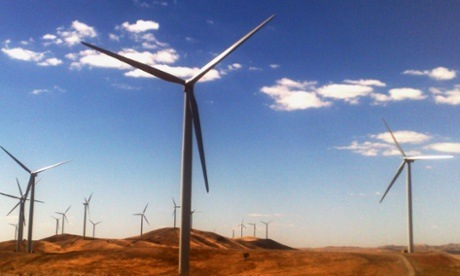
An acoustic engineer is threatening to sue the ABC’s Media Watch over claims he and his research on the health effects of windfarms were misrepresented on a recent program.
A 16 February episode of Media Watch fiercely criticised a report by the Australian’s environment editor Graham Lloyd that claimed a study by acoustician Steven Cooper had found that people living near windfarms faced a greater risk of suffering health complaints.
The first paragraph of Lloyd’s article said: “People living near windfarms face a greater risk of suffering health complaints caused by the low-frequency noise generated by turbines, a groundbreaking study has found.”
Cooper had that claim put to him by Media Watch and said it was incorrect. “The report doesn’t say anything about noise … You can’t say that noise affects health from this study,” he said.
But Cooper told Guardian Australia on Monday he had been misrepresented and had formally asked for a retraction. He was also considering legal action over the “ridiculous and defamatory” claims in the program regarding his work.
He said Lloyd’s claim in the Australian was borne out by previous research that had shown a link between health complaints and windfarms – on which his report was building. “I do not say in the report at any time that the noise is affecting people’s health,” he said.
“But if you take the study and if you have a knowledge of the subject, of what’s being done elsewhere … then in terms of all of that, the study gives you the links as to cause and effect.
“Graham Lloyd has actually studied this stuff … His first paragraph is correct because he has the knowledge of what’s gone on before and how this relates to my work.”
In claiming upfront that Cooper’s report showed a link between health complaints and windfarms, Lloyd had simply “saved 12 paragraphs of writing”, he said.
Media Watch host Paul Barry quoted various experts fiercely attacking Cooper’s study.
Among his criticisms were the tiny sample size, just six people, and the fact the research had not been peer reviewed. Barry also said the participants had all previously complained of windfarms causing adverse reactions – an example of “selection bias”.
But Cooper said the brief he was given by the windfarm operator, Pacific Hydro, was to take measurements to find whether the participants’ complaints could be related to certain wind speeds and sound levels.
“The research actually acknowledged that these people are all affected by the windfarms,” he said.
“What my report found is that when the windfarm was operating in certain modes then the residents reported higher sensation, noise or vibration impacts; and at other times they reported lower sensation, noise or vibration impacts.”
Despite Cooper’s conclusions, the link between the infrasound or low-frequency noised produced by windfarms and health complaints is yet to be proven.
A South Australian study conducted two years ago found that infrasound and low-frequency noise levels near some of the state’s windfarms were no higher than in urban locations, or rural locations away from any wind turbines.
A December 2014 study found that walking at the pace a wind turbine spins could produce infrasound that was “considerably higher than the level near windfarms”.
Links between health complaints and windfarms have been rejected by two Senate inquiries. A recent evidence review by the National Health and Medical Research Council found there was “no consistent evidence that windfarms cause adverse health effects in humans” – but called for more research on the subject.
Media Watch said in a response that it stood by its story.
